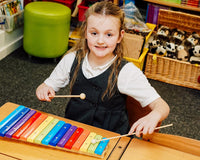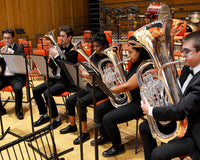Guitar vs Piano
Many of the differences between learning Guitar and learning Piano lie in the notation and terminology. It’s absolutely possible to advance to high levels of Guitar expertise without reading music, knowing which notes are in which chords and what a chord voicing or inversion is. These things generally aren’t introduced until higher levels of study, with Guitar tablature (tabs), learning-by-listening and chord diagrams generally favoured. I would strongly recommend not being restricted to only these purely Guitar-focused things. It’s fairly easy to see how a more holistic approach including the notation reading/chord voicing topics mentioned above will make you a better all-round musician: Able to notate ideas, write orchestrations and arrangements, understand your keyboard player’s part or write a truly interesting Bassline. But what can this do specifically for your Guitar playing?Here are 3 ideas:
1. Chord Tones
- “Chord Tones” simply means the notes in any given chord. So C Major’s chord tones are C, E, G. Generally, when learning Guitar chords, we don’t learn which notes are in which chords.
- We know one of the notes in a chord, its root note or ‘tonic’ as this is the note giving the chord its name. But we won’t usually know the other notes making up the chord because we learn the chords as shapes - patterns memorised from diagrams.
- It centres around what configuration of fingers should hold which position, to make the required sound. On the Piano, it works the other way - you will learn that C Major = C, E, G, and D minor = D, F, A, meaning the chord tones are learned from the beginning.
- Should you forget what notes make up a chord, you only have to look down at your hand - the Piano’s keys are all called C, D, E, F, G etc. - each one is named after the note that sounds when it’s played, as opposed to the Guitar’s method of thinking of the note as “Fret 4 on the 1st string”.
- The reason it’s so important to know all of this relates to creating second guitar parts, harmonies, overdubs and guitar solos.
- OK, so your learned scales can give you a good bank of safe notes, but the best, most musical parts are created when specific notes are deliberately targeted at specific times, to coincide with the chords underneath. i.e. Knowing the underlying chord is F Major (F, A, C) and therefore landing on an A note rather than a B note.
2. Reading and Writing Music
- On first glance, it’s fair to say you can take your Guitar playing to high level without the ability to read or write notation. But on closer inspection, I’d dispute whether that’s actually the case.
- It comes up in a lot of unexpected places along the way: The increasing number of Guitar tab websites that include rhythm notation to help with phrasing and timing, (likewise magazine transcriptions and video tutorials), the score and piano roll editing sections in a DAW/recording software, learning Classical Guitar pieces, having to describe or notate an idea to band members who are used to standard notation.
- A Pianist or Violinist for example, and the sight reading test that’s a component of the audition for all the contemporary music Higher education institutions in the UK.
- It’s more than fair to say a bit of reading and writing music will help you and do a huge amount for your Guitar playing. Given that standard notation is the language of Piano, learning a bit of basic Piano is a great way to ease into understanding how to read notes and what a certain rhythm looks like.
- Then you can try to transcribe a favourite Guitar solo, or write out some of your strumming patterns in rhythmic notation.
3. Voicings and Inversions
- A chord’s ‘voicing’ is how the notes within it are stacked or arranged. As I mentioned above, the chord of C Major is formed of the notes C, E, G. This can be ‘inverted’ to 1st inversion - E, G, C, or 2nd inversion - G, C, E. All 3 are C Major chords, just different inversions, creating slightly different sounds, evoking slightly different emotional responses, and serving different purposes when played as part of a chord progression.
- This is by far easier to understand and appreciate at the piano than the guitar, due to the linear way in which Piano chords are formed, one note, plus another, plus another, rather than a memorised shape on the Guitar.
- Learn a simple song on the Piano, something like Let It Be by The Beatles, and study how different inversions of the chords are being used to create or suggest melody and movement.
- Experiment with playing all the chords in standard, root position, versus playing them all in 2nd inversion, for example. Why did The Beatles use the particular inversions they used?
- When you then return to your Guitar playing, try to take some of this knowledge with you, and you’ll be writing more interesting chord patterns with more depth, or using a creative bassline to turn your Guitar part’s simple chords into inversions.
- So go and secure yourself a keyboard of some sort, whether it’s a half-broken old toy keyboard from your parents’ loft, or the Grand Piano in your living room - go and get your hands on the keys, and watch your musicality and Guitar playing grow. Good luck!















